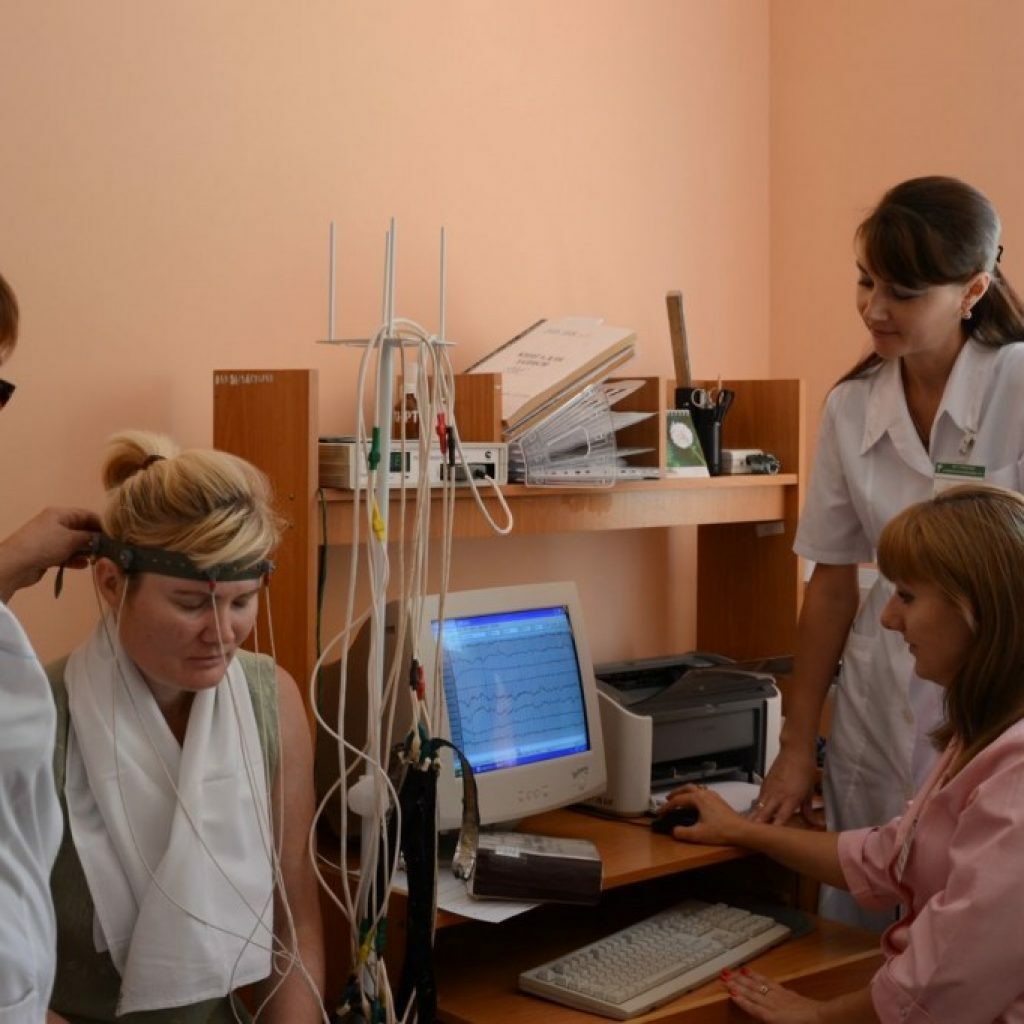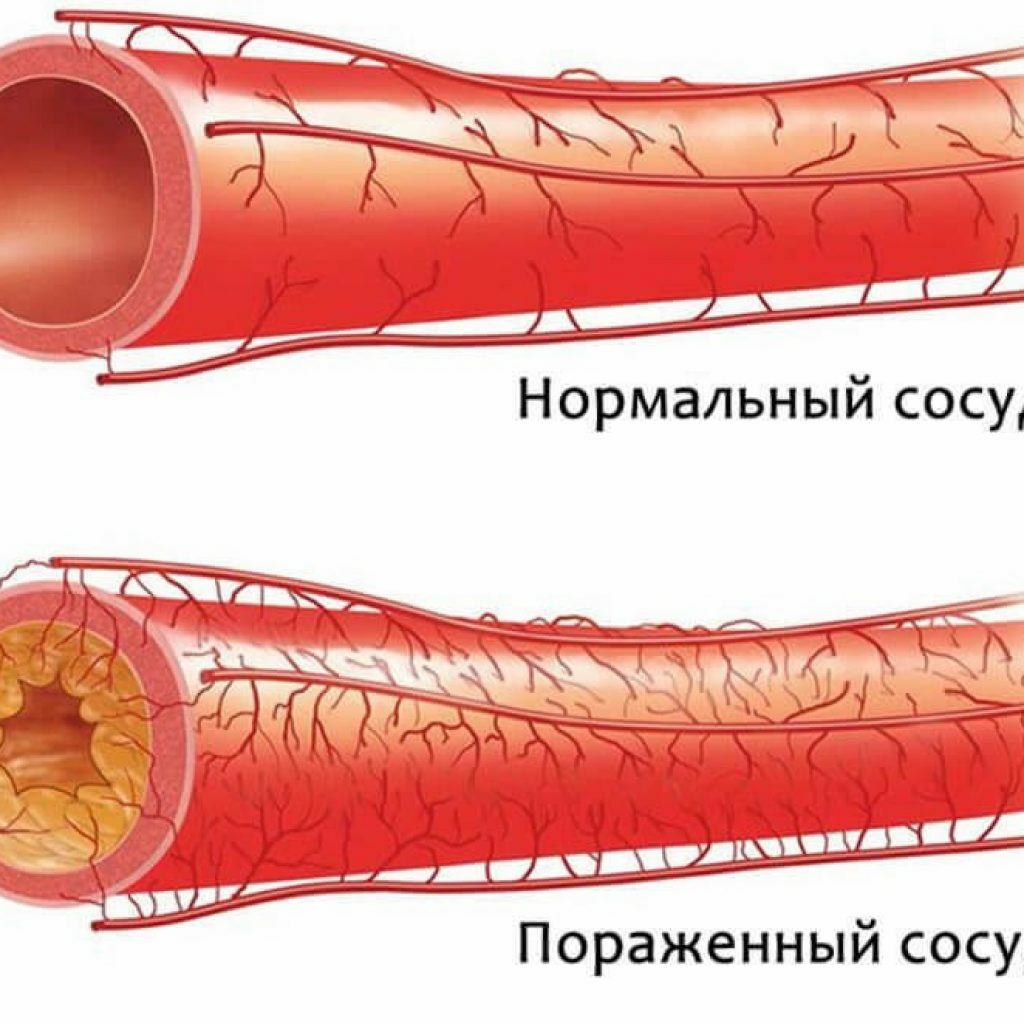Cardiovascular diseases occupy leading positions among the causes of death in modern civilized society. Even people far from medicine know what is atherosclerosis, ischemic heart disease, myocardial infarction, stroke. However, not everyone knows such a disease as an aortic aneurysm. The most common aneurysm of the aorta, located in the abdominal cavity.
Contents of
- 1 What is an abdominal aortic aneurysm?
- 2 The causes of the disease
- 2.1 Risks of abdominal aortic aneurysm - video
- 3 Classification
- 4 Symptoms of abdominal aortic aneurysm
- 5 Methods of diagnosis of aneurysm of the abdominal cavity
- 6 Treatment
- 6.1 Folk remedies in the treatment of aneurysms
- 6.2 medicaments in the treatment of diseases
- 6.3 Surgicaloperations with aneurysm
- 6.3.1 Procedure for surgical intervention for resection of aneurysm
- 6.3.2 A new method of operative treatmentI - implantation of endovascular stent graft
- 6.4 Possible complications
- 7 Diet: what products can not be used
- 8 patient rehabilitation after surgery
- 9 Testimonials
- 10 forecast
- 11 disease prevention
What is abdominal aortic aneurysm?
The aorta is the main vessel of the body, having the largest diameter and feeding the entire body with blood. In the structure of the aorta, the following departments are distinguished:
-
ascending aorta - carries blood supply to the heart muscle;
-
aortic arch - carries blood to the organs of the head, neck and upper limbs;
-
thoracic aorta - nourishes the thoracic cavity( lung, esophagus, trachea, diaphragm), intercostal muscles;
-
abdominal aorta - supplies blood to the organs of the abdominal cavity, small pelvis and lower limbs.
Depending on the location of the aortic site relative to the renal arteries, the suprarenal( located above the renal arteries), the intracranial( at the site of the renal arteries) and the infrarenal( below the divergence of the renal arteries) are separated.

Location of aneurysm in the aortic departments of the
The term "aortic aneurysm" implies a significant widening of its diameter. It can affect both a separate area of the vessel and several departments right up to the development of the pathological process throughout its entire length. Aneurysm can form in any part of the aorta, but most often it is found in the abdominal cavity.
The walls of the aorta are strong and elastic and can withstand sudden changes in pressure within a huge range. However, with the development of an aneurysm, the tissue of the vessel can partially lose its properties. Then the weakened part of the aortic wall begins to bulge, unable to withstand high internal pressure. If such an expansion exceeds half the diameter of the unaltered aorta, it is called an aneurysm. Most often, the disease occurs in men over 60 years.
The disease may not manifest itself in any way, but there is a risk of a sudden rupture of the aneurysm, in which the patient is most likely not saved. Aneurysm of the abdominal aorta takes 15th place among the causes of death.
Causes of the development of the disease
The reasons for the formation of aneurysms include:
-
Atherosclerosis, leading to the appearance on the aortic wall of plaques from cholesterol( 90-96% of all cases of aneurysms).The process is complicated by the formation of calcifications and the proliferation of connective tissue, which makes the vessel fragile.
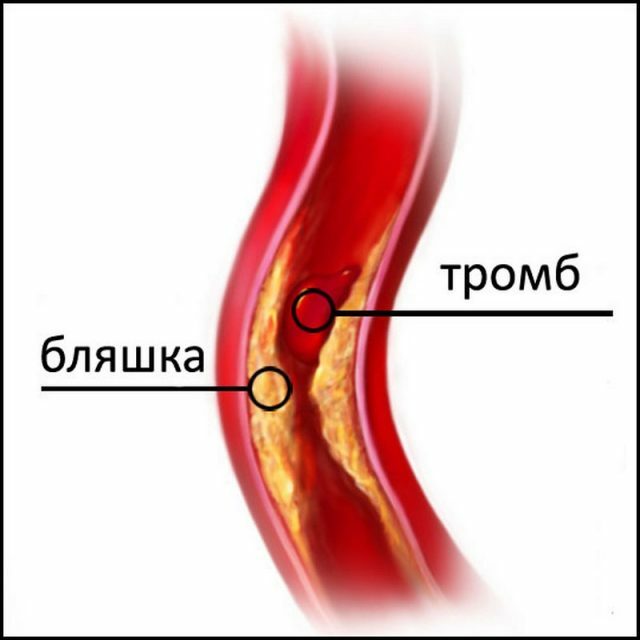
Atherosclerotic plaque as the basis for the formation of the aortic aneurysm
-
Aortitis is an inflammatory process in the walls of the aorta;
-
Congenital malformations of the vessel( so-called coarctation of the aorta);
-
Congenital systemic connective tissue diseases, for example, Marfan syndrome;
- Injuries of the aortic wall( wounds, car accidents);
-
Complications after interventions on the aorta.
Additional factors in the development of aortic aneurysm include white race, age, the presence of bad habits( smoking), arterial hypertension, atherosclerotic lesion of other arterial basins.
Risks of aneurysm of the abdominal aorta - video
Classification of
- True aneurysms are a direct expansion of the vessel in diameter relative to normal dimensions. In form, such aneurysms can be saccate and fusiform.
- False aneurysms - the aneurysm cavity is filled with blood due to aortic wall defect( eg, in trauma).
- The dissecting aneurysms are the sudden occurrence of a defect in the aortic wall and the penetration of blood between the shells of the vessel, as a result of which a tissue flap is formed in its lumen.
Symptoms of an aneurysm of the abdominal aorta
The clinical picture of an abdominal aortic aneurysm can be different:
- An option is possible in which there are no signs of disease, an aneurysm is not determined by objective examination( asymptomatic form).
- The second option is that there are no pain sensations, but an aneurysm can be determined by probing the anterior abdominal wall as a tumor-like pulsating formation.
- The third option is characterized by pain of varying intensity in the abdomen, giving back, lower back, sacrum. In addition, this type can include a number of additional symptoms: circulatory disorders in the intestine( vomiting, constipation and other disorders), renal blood flow( urination disorder), blood supply to the lower extremities( intermittent claudication).
In the stage of development of complications there are symptoms of a threatening rupture( intense pain), rupture( internal bleeding clinic - frequent pulse, low arterial pressure) and stratification.
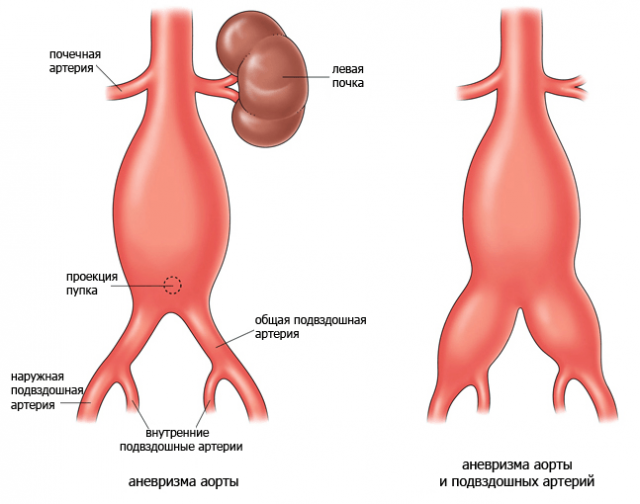
Aneurysm of the abdominal aorta
Methods for diagnosing an abdominal aneurysm
In order to make a correct diagnosis, careful collection of an anamnesis( patient complaints, predisposing factors, concomitant diseases and bad habits) is necessary. In addition, the doctor may prescribe additional research methods:
-
Ultrasound scanning of the aorta and arteries - the size of the aneurysm, the presence of thrombi in its lumen, the separation of the aortic wall and the outgoing arteries are determined.
-
Computed tomography of the aorta allows you to determine the prevalence of an aneurysm, its size at different levels, the presence of stratification.
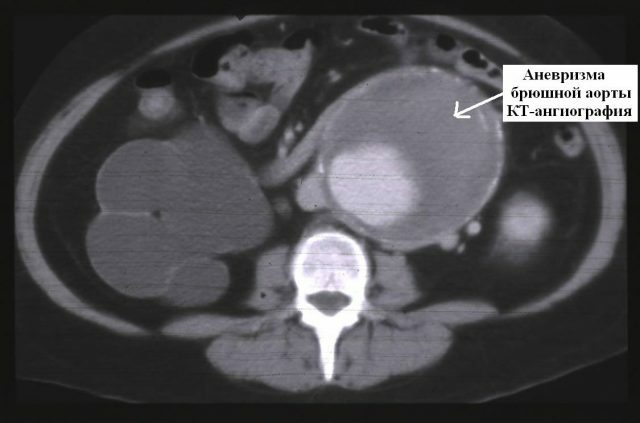
Computed tomography of the abdominal aorta
-
Magnetic resonance imaging, which allows to obtain a high-resolution image.
-
Angiography of the aorta - examination of the vessel using an X-ray machine.
-
Surgical treatment of an aneurysm should be preceded by visualization of the heart vessels, cerebral blood flow and circulation of the lower extremities by ultrasound.
Treatment
You should not hesitate to go to the doctor to establish an accurate diagnosis. The main method of treatment of aneurysms is operative. Procrastination is life-threatening.
Folk remedies for the treatment of aneurysm
Effective folk remedies for the treatment of an aneurysm of the abdominal aorta do not exist, because it is based on a violation of the integrity of the vessel.
Drugs for the treatment of
disease An aneurysm medication must be medicated to correct arterial pressure in the aorta and the therapy of concomitant diseases( coronary heart disease, myocardial infarction, stroke).The following drugs can be prescribed by a doctor:
- beta blockers - normalize blood pressure and heart rate( Concor, Coronale);
- inhibitors of ACE( angiotensin-converting enzyme) - normalize blood pressure( Perindopril, Fosinopril);
- preparations of acetylsalicylic acid - improve blood flow, reduce the likelihood of blood clots( Aspirin, Trombo-Ass, Aspirin-Cardio);
- statins - reduce the level of cholesterol in the blood, prevent the formation of atherosclerotic plaques( Liprimar, Atorvastatin, Torvacard).
Surgical operations for aneurysm
The most common tactic for an aneurysm of the abdominal cavity is surgical intervention. However, the choice of technique depends on the state of the organism and the presence of complications. If the aneurysm is small, the doctor can offer a wait-and-see tactic. Also, the presence of possible contraindications to surgical treatment is taken into account. These include:
-
myocardial infarction less than 3 months old;
-
stroke less than 6 weeks old;
-
marked changes in the lung;
-
common atherosclerosis of lower extremity arteries
In an emergency situation, i.e., with rupture of an aneurysm, there are no contraindications.
Procedure for surgical intervention for aneurysm resection
Resection of the aneurysm of the abdominal aorta is the surgical excision of the aortic aneurysm and the subsequent stitching of the prosthesis. Access to an aneurysm is carried out under general anesthesia by cutting the abdomen along the midline. When an aneurysm is located below the retreat of renal vessels, the main method of surgery is intramuscular prosthetics - dissecting the affected area, inserting the prosthesis, sewing on top of the abdominal aorta. It is also possible to remove the affected area of the aorta and then restore integrity.
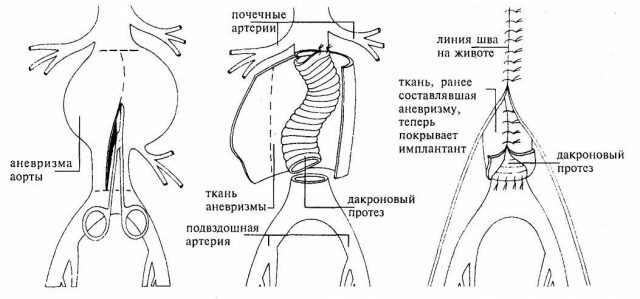
Scheme of intramuscular abdominal aortic prosthesis operation
When the aneurysm is positioned above the renal vessels, the prosthetic repair of the renal arteries is added to the main stage of the operation.
A new method of surgical treatment - endovascular implantation of the stent graft
The development of medicine and the results of technological progress led to the development of a fundamentally new method for treating aortic aneurysms, called endoprosthetics. The stent-graft is a metal structure implanted into the aortic lumen to strengthen its wall. Installation of the stent graft is performed through the puncture of the femoral artery with a balloon and delivery system under the control of an x-ray image. The merits of the method include the absence of anesthesia and operational trauma.

A new treatment for aortic aneurysm - implantation of the stent graft
Possible complications of
Surgical intervention carries certain risks. According to statistics, most often there are such complications as:
-
significant blood loss;
-
myocardial infarction;
-
stroke;
-
difficulty breathing;
-
circulatory disorder in the intestine;
-
kidney failure;
-
worsening of the blood supply of the lower limbs;
-
infection of the prosthesis.
Diet: what foods can not be taken to a patient
Patients are encouraged to follow a diet and healthy eating principles.
Foods recommended for use:
- vegetables( broccoli, beans, kidney beans, pumpkin);
- fruit( avocado, grapefruit, pomegranate);
- lean meat( rabbit, turkey);
- pasta from hard wheat varieties;
- bread made from wholemeal flour;
- fish( salmon, trout, tuna, sardines).
Foods subject to restriction:
- bread and pasta from premium grade flour;
- chocolate( except black);
- fatty meat( lamb, pork);
- fat;
- sweet fizzy drinks;
- cream confectionery;
- mayonnaise;
- butter;
- sausages;
- sharp spices.
Rehabilitation after surgical intervention
In the postoperative period the patient is for some time in the intensive care unit. In the future, it is necessary to limit physical activity, wearing a bandage, taking prescription medications, controlling cholesterol and blood pressure. Computer-assisted or magnetic resonance imaging is performed within the framework of clinical observation.
Patient feedback
Operation for an aneurysm of the abdominal aorta is complex and time-consuming. But with timely access to a specialist, there are great chances for a successful outcome.
Unfortunately, the postoperative period is different for all patients, the state of the organism and the presence of concomitant diseases are of great importance.
Forecast
Aneurysms of the abdominal aorta of medium and large sizes inevitably progress with the outcome in the rupture. Aneurysms of small size can for a long time maintain a stable state. Surgery on the aorta is extremely difficult and involves many possible complications, so you need timely treatment to the doctor and compliance with preventive measures.
Prevention of the disease
Preventive measures include:
-
a family survey to identify the family nature of the disease;
-
timely detection and treatment of atherosclerosis;
-
diagnosis and treatment of hypertension, ischemic heart disease;
-
refusal of smoking and a healthy lifestyle.
An aneurysm of the abdominal aorta - a serious disease of the cardiovascular system, relates to life-threatening conditions, so it is especially important that patients receive timely medical treatment.


